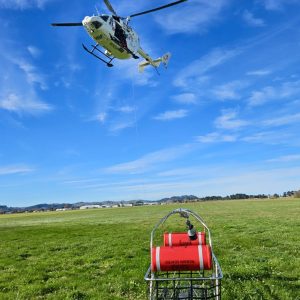Like the central link in a multi-threaded chain, rescue helicopter crewmen need to quickly receive, process, prioritise and communicate information between everyone from the pilot and critical care paramedic to on-ground first-response crews, the Airdesk, and hospital contacts.
“So while practical skills are critical, the things that make a fantastic crewman are good communication and an ability to think on their feet,” says crewman trainer Phil Mudgway.
“If they have that, along with good spacial reasoning and awareness, they’re off to a great start.”
Phil works for Search and Rescue Services Ltd, the operating company formed by five North Island rescue helicopter organisations, including the Eastland Helicopter Rescue Trust (EHRT).
As such, he and fellow crew trainer Aeron Mellish are frequent visitors to EHRT’s Gisborne hangar where they work with the Trust Tairāwhiti Eastland Rescue Helicopter’s team of four crewmen.
Between them, the four cover shifts 24/7, 365 days a year, so they need to have capabilities working both night and day, often in challenging conditions.
“One was already trained when he came on board – though I did his induction training with him – but we’ve worked with the others since they first started, both at our (Taupo) training base and here in Gisborne,” Phil says.
“The training is pretty intensive at the start and is ongoing from there, and their skills are tested with annual proficiency checks.”
Like many rescue helicopter team members, both Phil and Aeron started their careers in the military, and Phil added to his skills crewing in commercial aviation environments overseas.
And while both still step up to do the occasional shift, their main focus is on upskilling SRSL’s force of crewmen both on and off the ground.
In terms of getting their helicopter from A to B crewmen do everything from refuelling to briefing passengers, offering navigational support, updating pilots about weather en route, and identifying and briefing landing sites, sometimes while using night vision goggles.
“They also have medical training so they can assist the on-board critical care paramedic, and they need good organisational skills as they’ll often be working on patient extraction plans,” says Phil.
“We work to bring all those qualities and skills together and keep developing them to build capability going forward.”
This week, that saw all four Eastland crewmen join Phil Mudgway for a special training session, culminating in brushing up their skills working with the collapsible rescue basket.
Designed for those with no or minor injuries, the basket is used to winch up two people in one hoist, making it critical equipment for rapid rescues.
EHRT treasurer Ian Parker says the basket is particularly useful over water “of which our region has a lot, so it would be invaluable in cases like a mass rescue”.
“It is a key piece of kit but, like anything in the aeromedical space, it didn’t come cheap,” he says.
“That’s why we’re so grateful for the ongoing support from our community and funders. They help keep our team well equipped for anything they might face in carrying out their life-saving missions.”
(FYI: Yes, the Eastland Rescue Helicopter team does have two female crewmen but, as far as they’re concerned, the word “crew-woman” does not exist. “Like many other services we use the original meaning of the word ‘man’, which just means ‘person’,” one former team member said. “The requirements for the job are not gender-specific, so neither should the job title be.”)
CAPTION: TRAINING DAY: Under the guidance of trainer Phil Mudgway, the Trust Tairāwhiti Eastland Rescue Helicopter’s team of four crewmen spent a day working on skills unique to their job, including managing the dynamic winching cycle needed to use the two-person rescue basket. Pictures by Lachlan Clark
